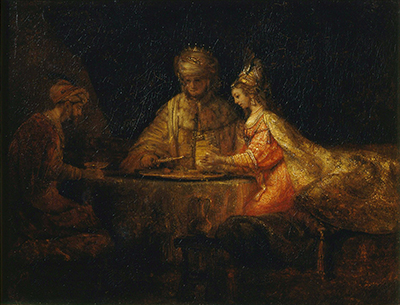Ahasuerus and Haman at the Feast of Esther is from chapters 5-7 of the book of Esther in the Old Testament which inspired Rembrandt in 1660 to produce this intriguing artwork
This religious tale has a deep connection with the Jewish faith and specifically the festival of Purim. King Ahasuerus proposes to hang the entire Jewish race for his own perceived disrepect but is talked around by his wife, Esther.
All these years later, the precise details of what went on are hard to know but certainly Haman remains the villain in the eyes of Judaism. These religious tales are normally passionate and extreme, making ideal inspiration for artists like Rembrandt to produce artistic depictions of them.
These banquets always offer a selection of interest within artistic compositions and paintings from around the Baroque period have had centuries of discussion to decipher the individuals as well as any symbolism that the artist may have used. It is believed that Esther has just finished her speech and awaits the verdict of her husband whilst Mordechai sits anxiously a fair distance away from the pair.
The Pushkin Museum in Moscow retains this dimly-lit artwork, just one of a sensational collection of fine arts from a variety of art movements and European regions. Within this significant institutions you will also find paintings by other famous names such as Jean-François Millet, Pablo Picasso, Canaletto, Edouard Manet, Gustave Courbet and Caspar David Friedrich.




